Confused About Green Certifications?

If you are confused about the “Green” certifications in the mattress industry you are not alone. Trying to get to the bottom of what the certifications mean can leave you “off-gassing” in frustration. Hopefully this little article can shed some light on subject for you.
You have probably seen labels claiming Green, Eco-friendly, Eco-green, Natural etc. To be blunt, these labels pretty much mean nothing in terms of actual measurable attributes. Other labels such as “No chemical fumes or off-gassing” and “biodegradable” are equally void of anything measurable.
For a certification to have merit it needs to comply with the following seven important standards:
- It needs to be industry specific.
- Accurate, consistent and clear.
- Independent third-party verified, and protected from conflicts of interest
- Meaningful (confers real benefits for ecosystems and people)
- Transparent (standards are publicly available)
- Collaborative (developed with public and industry input)
- Have a marketing asset (has a memorable name, a recognizable logo)
Here at Essential Sleep all our mattresses have certifications that meet the above criteria. That way we can be sure that we are selling products that are completely safe to our customers. The certifications with the most clout (because they follow the 7 standards to a "t") are Oeko-Tex, GOTS and GOLS. Here is a detailed explanation of each:
Oeko-Tex

Oeko-Tex was founded to provide an objective and reliable product label for consumers and a uniform safety standard for the assessment of harmful substances in fabrics. Its aim is to ensure products are free of harmful substances. The Oeko-Tex Standard 100 excludes harmful substances or limits their use. The following parameters form part of the Oeko-Tex list of criteria:
Specifically banned:
- Brominated flame retardants (penta, octa, deca, others)
- Chloro-organic toluenes and benzenesFormaldehyde*
- Pesticides
- Extractable heavy metals
- Phthalates* in baby articles
- Emissions of volatile components (VOCs) including toluene, styrene, butadiene and others
- AZO dyes*
- Carcinogenic and allergy-inducing dyes
- Chlorinated phenols
- Organotin compounds (TBT and DBT)
Oeko-Tex’s labs test for not only harmful emissions, but also risks associated with skin contact and ingestion. Certification lasts for only one year, so be sure to verify that a company’s certification is up-to-date.
Global Organic Textile Standard (GOTS)
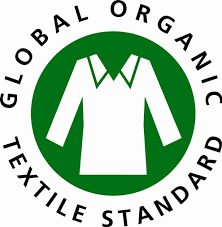 GOTS is a certification for “organic” textiles made with organically grown raw fibers and for textiles made with organic fibers that have been processed into textile without harmful chemicals. Here’s a summary adapted from O Ecotextiles:
GOTS is a certification for “organic” textiles made with organically grown raw fibers and for textiles made with organic fibers that have been processed into textile without harmful chemicals. Here’s a summary adapted from O Ecotextiles:
The Global Organic Textile Standard (GOTS) aims to define a universal standard for organic fibers—from harvesting the raw materials, through environmentally and socially responsible manufacturing, to labeling—in order to provide credible assurance to consumers. There are also social responsibility components (i.e., fair wages, no forced or bonded labor, etc.) All parameters are listed and accessible. The GOTS parameters for materials include prohibitions or restrictions on:
- Formaldehyde and short chain aldehydes
- Heavy metals
- Aromatic solvents
- Chloro Phenols (TCP, PCP)
- Complexing agents (APEO)
- Fungicides and biocides
- Halogenated solvents
- Ammonia treatment
The GOTS certification applies to only natural fibers…(not) polyester or other synthetic fibers.
Be sure to look out for whether a material claimed to be organic simply comes from an organically grown crop or has also been processed into a textile without harmful chemicals (GOTS).
Global Organic Latex Standard- GOLS
 GOLS is an organic certification specifically developed for latex foam. To label a product GOLS certified the product must have:
GOLS is an organic certification specifically developed for latex foam. To label a product GOLS certified the product must have:
- 95% certified organic raw material of the total weigh
- No pesticides or chemical based fertilizers have been used on the land for three to four years
- Regular soil and leaf testing must be carried out and water samples taken daily.
- The place of manufacture must have a written policy in place for the management of any waste and/or pollution created in the manufacturing process.
- There are also strict policies regarding working hours, living wages, child labor etc.
- The certified organic latex must be stored separately from any regular latex.
Other Certifications:
Two other certifications worth mentioning are GreenGuard and CertiPur-US. Both certifications are good but they also both have some drawback that consumers need to be aware of.
GreenGuard:
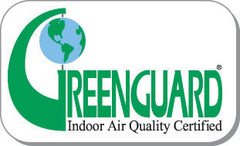 For people concerned about health effects of VOCs from adhesives (and other chemicals) used in mattresses, you may encounter the GreenGuard label. Here’s a description adapted from O Ecotextiles:
For people concerned about health effects of VOCs from adhesives (and other chemicals) used in mattresses, you may encounter the GreenGuard label. Here’s a description adapted from O Ecotextiles:
GreenGuard…tests for the emitting chemicals coming from a product; that means it tests only for evaporating chemicals, chemicals that are a gas at room temperature. To be clear – that is all GreenGuard does. They do not measure or test for:
- Any of the heavy metals (lead, mercury, copper, etc.)
- PVC, which is a polymer and therefore not volatile
- Phthalates (except in the Children and Schools certification).”[1]
So be aware, GreenGuard certification only means that no toxic VOCs were detected during emissions testing. It doesn’t mean that there are no toxic substances in the mattress, itself.
CertiPUR-US®
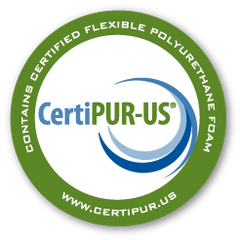 CertiPUR-US® was “developed by members of the global foam industry”. The label’s standards and independent testing provide meaningful quality and safety assurances.
CertiPUR-US® was “developed by members of the global foam industry”. The label’s standards and independent testing provide meaningful quality and safety assurances.
CertiPUR-US® focuses strictly on the safety and quality of polyurethane foams. According to the Ecolabel Index, is a voluntary standard to advance the safety, health and environmental (SHE) performance of flexible polyurethane foams used in bedding and upholstered furniture. The scheme takes into account existing standards and scientific studies related to emanations from foams, product criteria and risk assessments.
A review of CertiPUR’s limit values for emissions and content testing reveals them to be overall similar to Oeko-Tex’s – in many cases the same, in others a bit weaker, in a few slightly stronger. CertiPUR tests for harmful emissions, content and durability, with parameters including VOCs, phthalates, ozone depleters, toxic metals, formaldehyde, methylene chloride and PBDEs. It does not simulate effects of ingestion or skin contact.
Conclusion:
This blog post provides a broad view of the green certifications that are widely used in the mattress industry. Hopefully this article has helped clear things up for you. If not, feel free to give us a call for more details.
Leave a comment
Comments will be approved before showing up.
Also in Essential Sleep Blog
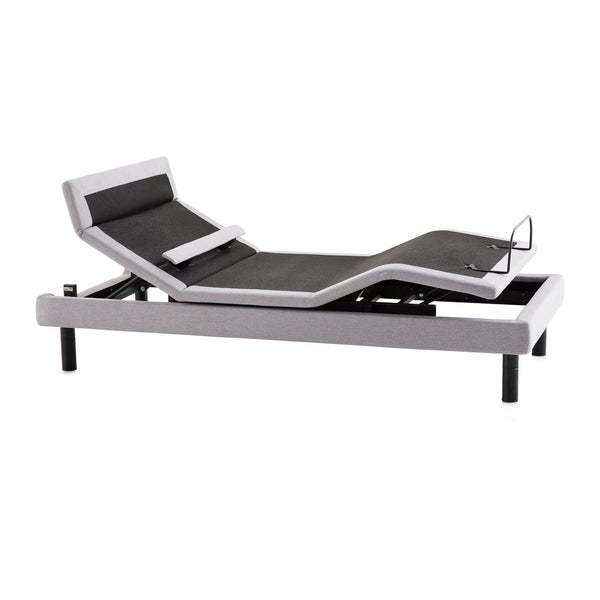
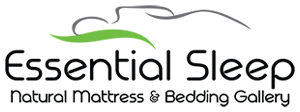

Chip Murison
Author